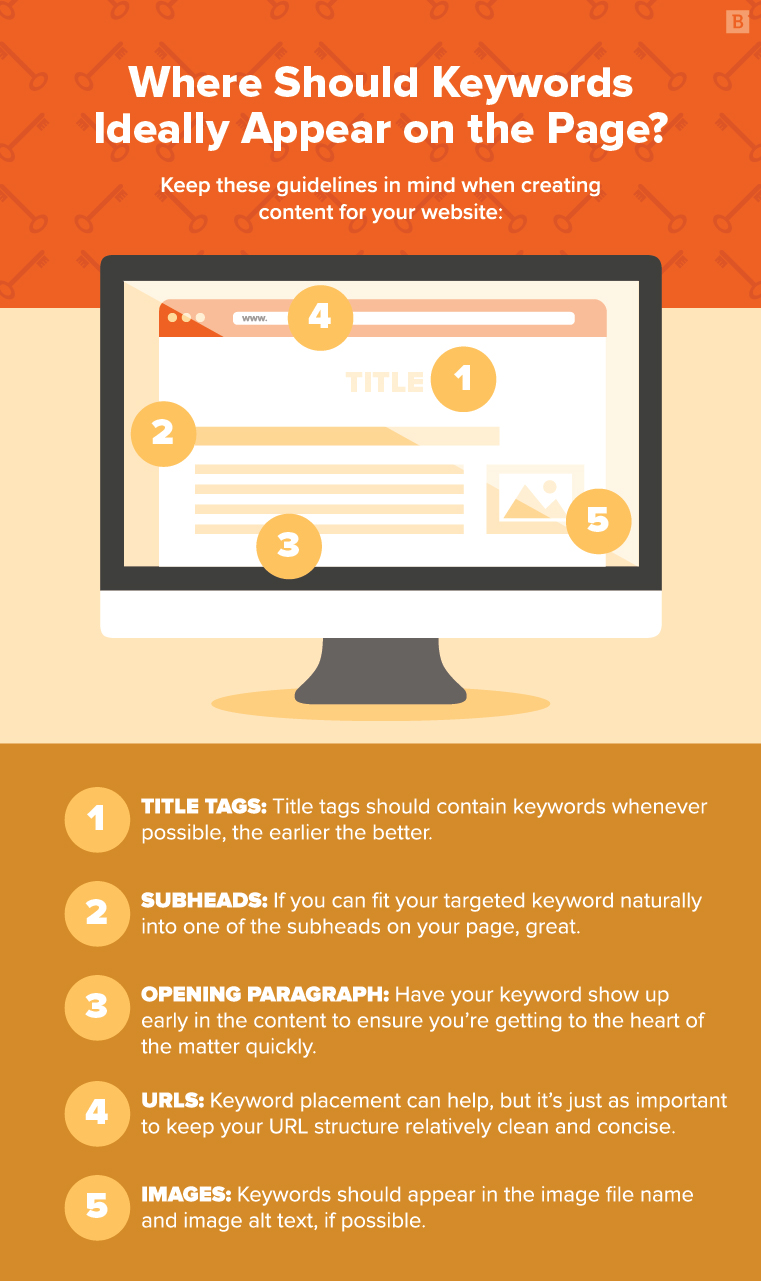Keyword optimization remains an essential component in any successful content marketing strategy – it’s just gotten more nuanced over time.
“Keyword stuffing” will no longer game the system and will, in fact, work against you. Year after year, Google moves the goalposts back on keyword optimization best practices. Techniques that worked just one year ago may no longer be relevant.
With that in mind, let’s take a look at the keyword optimization techniques that can work for you:
1 page = 1 target keyword
A webpage doesn’t exist so you can plaster as many keywords as possible onto it. Every page should be thought of as an individual entity with a singular root — or target — keyword it is optimized for.
By keeping each page focused on a target keyword, you can more easily structure your titles, headings and flow of your article. From there, you can work in semantically related secondary keywords to further bolster the comprehensiveness of your page.
A single primary keyword can also narrow down the intent of your page so that it perfectly matches the intent evident in every search result. Often, marketers created mixed-bag blog posts or landing pages that try to please ALL readers. What you need to do, though, is please high-value, intent-driven readers.
So, determine whether each page and each target keyword is correctly serving commercial intent (“buy”) or informational intent (“learn”).
Owning keyword share
Because creating a website and posting content has such a low barrier to entry, there are tons of irrelevant, unoptimized pages out there. Plus, there are direct competitors that are creating similar content to you.
All of this adds up to total keyword ownership being totally fragmented. Your job is to siphon more of that traffic to your site by owning more of those relevant keywords. Every blog post has the potential to shift more and more search volume to your site and subsequently deplete the existing traffic that goes elsewhere — specifically your competitors. Win-win.
Thankfully, there are numerous tools available to generate search queries, offer suggestions and help build out initial keyword lists.
In fact, there may be too many out there, making it difficult at times to cut through the noise and find the most effective platform.
Here are a few our team recommends to help get you started:
Long-tail keywords for voice search and more
Voice search queries and traditional search terms are inevitably going to diverge from one another — a trend that is becoming more evident each year.
When someone speaks into a voice search app, they will almost certainly use a more conversational tone. Whereas if they might type “keyword optimization best practices” into the Google search bar, they are more likely to say “Google, what are the best keyword optimization techniques I should use?” when using the voice search tool.
As such, long-tail keywords that reflect that conversational tone will become more useful and better match the user’s intent with the right piece of content.
This all translates to content that includes longer-tail keyword phrases often in the form of a question. Think FAQ pages, glossaries and other long-form guides that contain lots of question-and-answer responses. This approach directly mimics what occurs in search engines.
As Search Engine Watch’s Rebecca Sentance noted, Google’s algorithms have become so efficient and accurate when connecting search terms to relevant answers and content, that people expect to find precisely the information they’re looking for on the first try.
Moreover, although the Internet of Things hasn’t exactly set the world on fire just yet, it’s growing at a pretty considerable rate, and more connected devices are finding their way into people’s everyday lives.
It’s not that far-fetched to imagine a day when every home has various devices with voice search capabilities and people can simply verbalize whatever questions come to mind and expect immediate, accurate answers.
Strategic keyword placement
Do you still rigidly adhere to a specific keyword placement practice? If so, you might be a little behind the times. These days, there’s no need to bang your head against the wall making sure that every single blog or piece of content has a keyword in the title, first subhead, etc. That being said, keyword placement still matters when it comes to on-page SEO.
So, where should keywords ideally appear on the page? Keep these guidelines in mind when creating content for your website:
1. Title Tags
Although this is nothing new, title tags should still contain keywords whenever possible, the earlier the better. That being said, don’t force a keyword into your title tag if it doesn’t fit organically. Whatever SEO benefits you might earn could be offset by having an awkwardly worded title tag.
2. Subheads
If you can fit your targeted keyword into one of the subheads on your page, great. Again, though, it should be a natural fit. And it doesn’t need to appear in the very first subhead, either. You can get just as much SEO value out of keyword placement in lower subheads.
3. Opening paragraph
Some content marketers will cram a keyword into the first 100 words of every single blog, come hell or high water. While it’s certainly still considered a good practice to have your primary keyword appear early on, you don’t want to miss the forest for the trees.
The important thing to remember is that your content should get to the point, and not have a long, droning introduction before actually diving into the meat of the topic. Use your keyword early in the content to ensure you’re getting to the heart of the matter quickly.
4. URLs
This is another area where a keyword could help, but it’s just as important to keep your URL structure relatively clean and concise. URLs should not be lengthy strings of alphabet soup.
5. Images
Images that appear within a blog are additional opportunities to inject some SEO-boosting elements into your site. Most notably, keywords should appear in the image file name and image alt text, if possible. It’s a pretty easy win for SEO-conscious marketers.

Additional tools to use
If you’re in the market for keyword research software, there are a handful that are going to be especially popular:
Ahrefs Keyword Explorer
For those content marketers who want as much information as possible and who love combing through long lists of potential keywords, Ahrefs Keyword Explorer is for you. A single query could bring back several thousand keyword suggestions, which could become overwhelming for some users. Ahrefs’ keyword database is refreshed on a regular basis, helping marketers find the latest trends in their targeted search terms. It also provides pretty comprehensive SERP and ranking difficulty analysis, giving users more context to the viability of a specific keyword. Ahrefs has a number of features included to help guide content marketers to the best possible search phrases – it’s as close to an all-in-one package as you’re likely to find.
SEMrush
SEMrush advocates often come back to the same point when talking up the tool’s capabilities: competitor analysis. SEMrush’s competitor analysis tools are second-to-none. You can see which keywords are performing the best for rival companies, analyze their own keyword strategies and even discover new competitors you didn’t even know existed.
KWFinder
Depending on your comfort level with keyword research and analysis, something as dense and extensive as Ahrefs may not be the right tool for you just yet. And that’s OK, because there are plenty of options out there for people who want a more streamlined and simplified process. Pound for pound, KWFinder is probably the best of the bunch. It balances ease-of-use with accurate and deep keyword insights.
The layout and dashboard are very user-friendly and intuitive to navigate. Filtering data and results is extremely easy for newcomers and results are presented clearly so anyone can dive in and get the information they need without dealing with a huge learning curve. Content marketers who have been around the block a few times and are interested in deeper analysis options may want to look elsewhere, but KWFinder’s a great tool for someone just getting their toes wet.
Moz Keyword Explorer
Despite some stiff competition, Moz’s keyword research tool remains as relevant as ever. Its keyword difficulty analysis and data filtering capabilities rank especially high compared against other options out there. He may be a tiny bit biased, but Moz founder Rand Fishkin called out its CTR Opportunity feature as an especially unique and helpful tool.

SpyFu
Want to know what keywords your competitors are not only ranking for but making the most money off of? SpyFu’s got you covered. This tool downloads the competition’s most profitable keywords across both paid and organic search, giving you previously unthinkable insight into your rivals’ SEO and content marketing strategies. There’s no shame in replicating their most successful tactics and poaching lucrative keywords – imitation is the sincerest form of flattery, after all.
Wait, what about Google Keyword Planner?
Google’s massively popular keyword tool is definitely useful – in the right context, though. It wasn’t really designed with organic search in mind; rather it’s geared more toward PPC terms. The more Google tweaks Keyword Planner for that specific use, the less relevant it becomes to organic search keyword research.
I’m good at picking just one keyword research tool, right?
Odds are you’ll get great results simply through one of the platforms above, but if you really want to cover all of your bases, it’s a good idea to compare research from different tools. It may just validate what your preferred keyword research tool already told you, but it could also highlight some competitive search terms you missed out on. If you have the time and resources to try out multiple keyword research tools, go for it!
Remember: Let keywords serve the content
If there’s one overriding keyword optimization trend to keep in mind, it’s that the SEO rules of the past aren’t nearly as inflexible anymore.
Is it good practice to place targeted keywords in particular locations within your content? Absolutely. But don’t be a slave to those recommendations. In the end, good content will win out. As Katrina Niemisto put it, there’s no magic formula to keyword density, so don’t focus too much on getting every blog just right in that regard.
If the content’s well-written, offers relevant, useful information and is enjoyable to read, people will find it – and search engines will too.
So, what’s the best way to approach keyword optimization?
To remember that it’s not the end-all and be-all of SEO success.
Important? Unquestionably.
But the content you put on the page will ultimately be a major deciding factor in your search ranking. You could have the best keyword strategy around, but if the high-quality content isn’t there to back it up, it won’t mean much.
Editor’s note: Updated May 2021.





